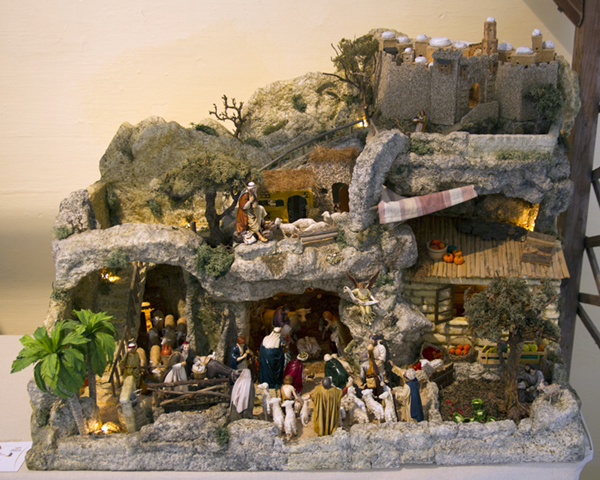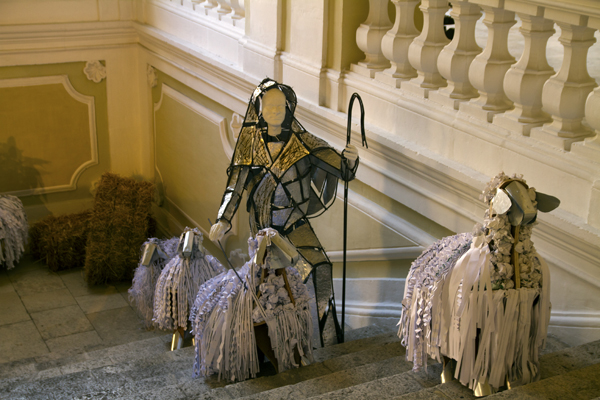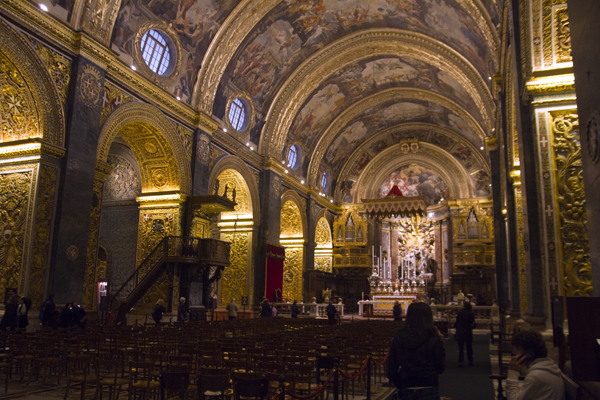On the second day of the new year (Sunday), I decided to go visit Valletta. It is now the capital of the island, but it is a relatively recent city. Indeed it was founded after the great siege of 1565 when Malta protected the rest of Europe from the invading Turks. REALLY! The siege lasted close to five months during which 700 knights and 8,000 ‘irregulars and mercenaries’ held of an invading force of more than 80,000 men. Relief finally came on 7 September and by 8 September, the Turks left defeated – 8 September is now the “National Day” of Malta. It took years after that before the Turks attempted another attack in Europe.
The Grand Master of the Knights of Malta at the time was called Jean Parisot de la Vallette. The new city of La Vallette was founded in 1568 at the time of his death, but in honor of his life.
I was welcomed into Valletta (as it is known in English) by an musical and flag waving escort. I wonder how they knew I was coming?
I had read in the plane flying to Malta that there was an exhibit ‘Creches’ (Nativity Scenes) at the Auberge d’Italie. I need to provide a little more history here …
The Knights of Malta were divided into eight ‘Langues’, for the eight nationalities that it included: Italy, France, Provence, Auvergne, Castile, Aragon, Germany and England. Each lived in its own ‘Auberge’; and these have been preserved in Valletta.
I have also discovered that Nativity Scenes are very elaborate in Malta and a very old tradition. The oldest Creche is in Mdina – unfortunately, I realised this AFTER I had visited the city, so no pictures.
However, I saw very nice modern creches at the Auberge d’Italie – this one is relatively small – in total less than 1 m tall
Whereas others were much larger and complex
I had already seen a beautiful Creche in the main church in Paola – the one with the silver domes – I skipped that photo until I could talk more on the subject.
The best Creche, for me, was at the Auberge de Castille – a life-size display that occupied the second floor and the grand staircase to reach it. Josef, Mary and Baby Jesus …
The sheep and real bales of hay…
and, of course, the three wise men…
I drifted towards the harbor and decided to go take a look at it from above at the St’s Peter and Paul Bastion and the Upper Barrakka Gardens. This is also the place for the ‘Saluting Battery’, a set of cannons used to salute visiting ships, but also used for the ‘Noon Day Gun’, a tradition in the British Navy used mainly to make sure that chronometers on board ships (used for navigation) were accurate before they set off to sea.
I took the guided tour where we were shown how to load a gun. One of the ladies on the tour was fascinated to hear that they have fired the gun every day at noon for many many years. She wondered that all those shells must eventually fill the harbor, or could be dangerous to vessels in the harbor. Our guide kindly explained to her that they were firing ‘blanks’, not real shells!
Then the the show began … the “troops” marched in. They are actually volunteers who do this in order to raise money so that they are able to continue to do this.
They went through all the right moves to load the cannon – I checked and indeed they did not put a projectile in the barrel so this is definitely a “blank” that they will fire at noon.
I took a very short video clip of the actual shot and I discovered as I was editing the clip (to make it compatible with my blog) that it even had sound – I did not think my ‘still’ camera also had a microphone…
You will see the video if you select the link below. It is still a large file (nearly 3Mb) so you will have to be patient depending on the speed of your connection.
I had lunch near St. John’s Co-Cathedral of Valletta. I talked about it in the first episode while I was in Mdina. This local pharmacy attracted my attention. I realise that I am not a native English speaker, and there are still subtleties of the language, or regional variations that occasionally escape me. Fortunately, I have a lotof friends and I am sure that at least one of them will be able to tell me what ‘Toilet Preparations’ are and why I would want to go to a pharmacy with a very large sign about it to get them…
Next, I visited the Grand Master’s Palace. The main entrance is though a passage into an inside courtyard and has a huge shield right on top of it. The small writing around the shield says ‘Honi soit qui mal y pense’, the motto of the ‘Most Noble Order of the Garter’. I was surprised ot see this here as this is a very British Order, very restrictive and the Knights of Malta were not dominated by the House of England – actually it was generally a minor house. This may have been added later, when Malta became part of the British Empire in the mid 1800’s.
There are very impressive galleries that prove the wealth that was accumulated by the Knights of Malta (or at least whan Napoleon could not take away when he stopped here on the way to Egypt – he left with two ships fully loaded with loot; both sank before getting back to France). The suits of armor here are only a few of the huge (more than 5000) that are kept in the armoury.
More views of the inside – the large paintings are portraits of the different Grand masters who occupied this building.
Before leaving Valletta, I decided to look for the Church of St Paul’s Shipwreck. It is said that St Paul spent time in Malta after he came back from Rome in 60 AD because his ship wrecked on the island. This is a large church, along a narrow street and there is no way to take a reasonable picture. So I took six photos and stitched them together using Photoshop. Far from perfect, but it gives a good idea of what the facade looks like.
There are three cities facing Valletta on the other side of the Grand Harbour. The main one of these is Vittoriosa and this is where I was heading next, by bus. In the yacht harbor of Vittoriosa, you get the idea that there is still a lot of wealth in Malta. Here is a nice modern reconstruction of an old design…
This is a private yacht!
I did not stay in Vittoriosa very long, as essentially everything was closed, and I could not get the views of Valletta I was hoping for, so I headed back to the capital for the sunset.
The entrance to Grand Harbour.
Because I was there on Sunday, I was not able to visit any of the churches in Valletta. I therefore returned early on the Monday to be able to go inside the St John’s Co-Cathedral.
Each Langue of the Knights of Malta had a chapel on the main nave; their strength and prestige is mirrored in the decoration of this chapel. In the Cathedral Museum, there are several paintings by Caravaggio, who spent many years in Malta after fleeing from Italy where is was accused of murdering a man after a tennis game.
Here too, there is an impressive Creche initially created many years ago.
That is is for Malta – I had to leave that afternoon to get back home.
(2005 Page Views)






















Toilet Preparations = Toiletries?
Pierre, there’s a lot of cultural history in Malta. Your timing to catch a parade was fortuitous.